Stenamma pelophilum
| Stenamma pelophilum | |
|---|---|

| |
| Scientific classification | |
| Kingdom: | Animalia |
| Phylum: | Arthropoda |
| Class: | Insecta |
| Order: | Hymenoptera |
| Family: | Formicidae |
| Subfamily: | Myrmicinae |
| Tribe: | Stenammini |
| Genus: | Stenamma |
| Species: | S. pelophilum |
| Binomial name | |
| Stenamma pelophilum Branstetter, 2013 | |
This is a rare species that inhabits montane wet forests from 1000 to 1800 m elevation. Most collections are from Winkler or Berlese extracts of sifted leaf litter. However, at Cusuco National Park in Honduras, I found two nests in a mud bank bordering a stream. The surface of the bank was rocky with an overlying layer of dense mud. The first nest was located by haphazardly cutting into the bank in an area where I saw lots of worker activity. This nest had a single chamber with about 35 workers and some brood. The second nest was located by following a returning forager. This nest had a nearly undetectable entrance (2 mm diameter) consisting only of a small hole, without any surrounding structure or excavated substrate. Behind the entrance was a very short tunnel leading to a single, small chamber. This contained 46 workers, some brood and a single dealate queen. When the nest chamber was disturbed, the queen immediately absconded out onto the clay bank followed by a series of workers carrying brood. Before excavation, foragers outside the nest were observed to be slow moving and solitary, similar to behavior in most other Stenamma species.
Identification
Branstetter (2013) - Integument mostly black to brown-black and shining; small to medium-sized species (see HL, ML, PrW below); anterior margin of clypeus with a shallow median emargination; basal margin of mandible straight to slightly curving, but without a distinct basal notch or depression; head and body almost entirely smooth and shiny, except for faint punctae on waist and sometimes on propodeum; pronotum in profile usually distinctly asymmetrical, with a long, steep posterior face, that forms a distinct angle with dorsal surface, and a short anterior face; eye of moderate size (EL 0.11–0.17, REL 19–23), oval-shaped, with 6–8 ommatidia at greatest diameter; propodeal spines reduced to small tubercles or short points (PSL 0.06–0.10, PSI 1.1–1.7); setae on gastral tergites sparse, moderately long, and mostly suberect; frontal lobes narrow (FLD 0.13–0.18, FLI 24–27), not obscuring torular lobe in full-face view.
S. pelophilum bears some similarity to Stenamma llama and Stenamma tiburon. It can be easily separated from these species by its distinctive promesonotum shape and average looking postpetiole, which lacks a distinctive dorsal lobe. There is minimal morphological variation amongst most populations of S. pelophilum.
Keys including this Species
Distribution
Mexico (Atlantic slope) to Honduras.
Latitudinal Distribution Pattern
Latitudinal Range: 23.062° to 14.94681°.
| North Temperate |
North Subtropical |
Tropical | South Subtropical |
South Temperate |
- Source: AntMaps
Distribution based on Regional Taxon Lists
Neotropical Region: Guatemala, Honduras (type locality), Mexico.
Distribution based on AntMaps
Distribution based on AntWeb specimens
Check data from AntWeb
Countries Occupied
| Number of countries occupied by this species based on AntWiki Regional Taxon Lists. In general, fewer countries occupied indicates a narrower range, while more countries indicates a more widespread species. |

|
Estimated Abundance
| Relative abundance based on number of AntMaps records per species (this species within the purple bar). Fewer records (to the left) indicates a less abundant/encountered species while more records (to the right) indicates more abundant/encountered species. |

|
Biology
Castes
Males have not been collected.
Worker
Images from AntWeb
  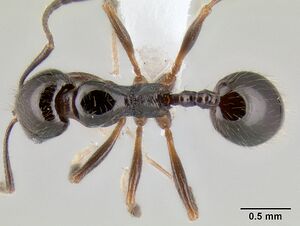 
| |
| Worker. Specimen code casent0605452. Photographer Michael Branstetter, uploaded by Default Group. | Owned by MGBPC. |
   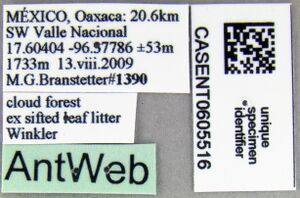
| |
| Worker. Specimen code casent0605516. Photographer Michael Branstetter, uploaded by Default Group. | Owned by MGBPC. |
   
| |
| Worker. Specimen code casent0606223. Photographer Michael Branstetter, uploaded by Default Group. | Owned by MGBPC. |
   
| |
| Worker. Specimen code casent0620146. Photographer Michael Branstetter, uploaded by Default Group. | Owned by MCZC. |
    
| |
| Worker. Specimen code casent0605613. Photographer Michael Branstetter, uploaded by Default Group. | Owned by MGBPC. |
      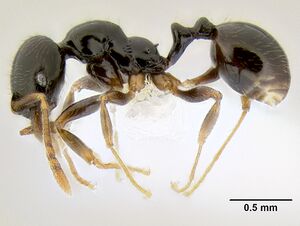
| |
| Holotype Stenamma pelophilum. Worker. Specimen code casent0622838. Photographer Michael Branstetter, uploaded by Default Group. | |
    
| |
| Worker. Specimen code casent0605428. Photographer Michael Branstetter, uploaded by Default Group. | Owned by MGBPC. |
   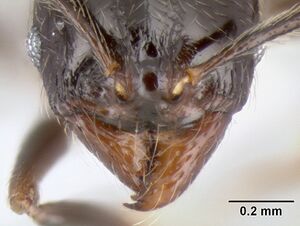 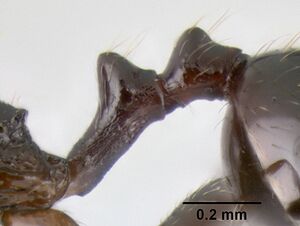
| |
| Worker. Specimen code casent0622846. Photographer Michael Branstetter, uploaded by Default Group. | |

| |
| Specimen code casent0622337. . | |
Queen
Images from AntWeb
  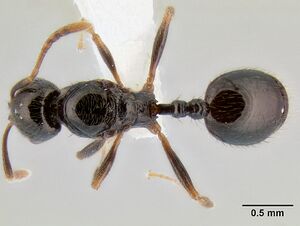 
| |
| Paratype Stenamma pelophilum. Queen (alate/dealate). Specimen code casent0622334. Photographer Michael Branstetter, uploaded by Default Group. | Owned by USNM. |
Nomenclature
The following information is derived from Barry Bolton's Online Catalogue of the Ants of the World.
- pelophilum. Stenamma pelophilum Branstetter, 2013: 214, figs. 138-140 (w.q.) HONDURAS, GUATEMALA, MEXICO (Hidalgo, Oaxaca, Queretaro, San Luis Potosi, Tamaulipas, Veracruz).
- Type-material: holotype worker, 19 paratype workers, 1 paratype queen.
- Type-locality: holotype Honduras: Cortés, Parque Nac. Cusuco, 15.48335°N, 88.22810°W±50m., 1290 m., 2.vi.2010, MGB1595 (M.G. Branstetter); paratypes with same data.
- Type-depositories: USNM (holotype); CASC, CFSS, EAPZ, FMNH, ICNB, INBC, JTLC, LACM, MCZC, MGBC, MZSP, UNAM, UCDC, USNM, UVGC (paratypes).
- Distribution: Guatemala, Honduras, Mexico.
Unless otherwise noted the text for the remainder of this section is reported from the publication that includes the original description.
Description
Worker
(17 measured) HL 0.58–0.83 (0.66) HW 0.51–0.73 (0.58) FLD 0.13–0.18 (0.15), PCW 0.03–0.05 (0.04), SL 0.49–0.76 (0.54), EL 0.11–0.17 (0.13), ACL 0.47–0.65 (0.54), ML 0.74–1.06 (0.86), PrW 0.38–0.47 (0.44), PSL 0.06–0.10 (0.09), SDL 0.05–0.09 (0.07), PL 0.27–0.39 (0.32), PH 0.18–0.24 (0.22), PW 0.12–0.17 (0.15), PPL 0.14–0.21 (0.18), PPH 0.14–0.19 (0.17), PPW 0.14– 0.20 (0.18), MFL 0.52–0.86 (0.62), MTL 0.41–0.67 (0.48), CI 86–92 (89), SI 89– 107 (92), REL 19–23 (21), FLI 24–27 (26), PSI 1.1–1.7 (1.2), PI 51–58 (54), MFI 83–105 (94), ACI1 64–71 (66), ACI2 84–99 (99)
Small- to medium-sized species; general body color black to brown-black, with mandibles and appendages brown to yellow-brown, lighter toward extremities; setae translucent brown; mandible with 4–6 teeth, consisting of 3 distinct apical teeth, a basal tooth, and 2 inner teeth, which are very often effaced; masticatory margin of mandible sometimes gently curving inward (perhaps due to wear), causing basal tooth to appear more robust; basal margin of mandible straight to slightly curving, without a distinct notch or depression; some specimens with basal section of mandible, where mandible inserts under clypeus, distinctly expanded and thin; dorsal surface of mandible mostly smooth and shining, with scattered piligerous punctae and a few basal striae; median lobe of clypeus somewhat obliquely flattened, and sometimes angled more ventrally than average, creating distinct dorsal and anterior faces; median lobe with faint to absent longitudinal carinulae, middle of lobe often slightly concave, apex of lobe with a short transverse carinula, usually present near anterior margin, remainder of clypeus mostly smooth and shining; posterior extension of clypeus between frontal lobes of moderate width (PCW 0.03–0.05), with subparallel sides; frontal lobes very narrow (FLD 0.13–0.18, FLI 24–27), not obscuring torular lobes in full-face view; head somewhat longer than broad (CI 86–92), roughly oval-shaped, posterior margin flat, never strongly depressed medially, lateral corners gently curving; eyes of moderate size (EL 0.11–0.17, REL 19–23), oval-shaped, with 6–8 ommatidia at greatest diameter; face almost entirely smooth and shiny, except for a variable number of carinulae around frontal carinae and on genae; scape of moderate to somewhat long length (SI 89-107), just reaching or slightly surpassing posterior margin of head when laid back; dorsal surface of scape with scattered piligerous punctae and a few faint striae, otherwise smooth and shining; funiculus with distinct 4-segmented antennal club; mesosoma usually almost entirely smooth and shiny, except for some longitudinal carinulae along metanotal groove, and transverse carinulae on dorsal and declivitous faces of propodeum; in some populations propodeum with more developed rugulae and punctae; promesonotum in profile usually asymmetrically domed and somewhat bulging, with posterior slope distinctly longer and straighter than anterior slope, and forming a more well-defined angle with dorsal surface, apex of promesonotum offset toward posterior margin; lateral and posterior margins of promesonotum in dorsal view, usually well defined, with relatively sharp transitions; one population (from high-elevation) with promesonotum in profile low-domed and roughly symmetrical; propodeal spines forming tubercles, or small projecting points (PSL 0.06–0.10, PSI 1.1–1.7); petiole of moderate length (PL/HW 0.51–0.58), node of variable height (PH/PL 0.59–0.69) and volume, usually pointing slightly posteriad, anterior face longer than posterior face and rising from about midpoint of petiole, posterior face nearly vertical, dorsum in profile usually narrowly rounded, but sometimes forming a defined apex; postpetiole in profile slightly to distinctly smaller than petiolar node (PPH/PH 0.76–0.89), roughly symmetrical, with anterior face slightly longer and more sloping than posterior face; petiole mostly smooth and shining, except for light punctae on venter and lateral portions of peduncle; postpetiole with anterior face smooth, shiny and shield-like, venter and posterior half of postpetiole lightly punctate; gaster mostly smooth and shiny, with scattered piligerous punctae; most of body with a thin layer of moderately long standing setae; setae on gastral tergites sparse and uniformly suberect; facial setae mostly decumbent with a few erect hairs; setae on scape subdecumbent to appressed; setae on legs mostly decumbent to appressed, with coxae and ventral surfaces of the femora with some suberect setae.
Queen
(3 Measured) HL 0.63–0.69 (0.69), HW 0.58–0.63 (0.63), FLD 0.14–0.16 (0.16), PCW 0.03–0.06 (0.06), SL 0.54–0.56 (0.56), EL 0.17–0.19 (0.18), ACL 0.53–0.56 (0.56), ML 0.91–1.02 (1.02), PrW 0.52–0.56 (0.56), PSL 0.09–0.14 (0.10), SDL 0.08–0.09 (0.09), PL 0.33–0.39 (0.37), PH 0.20–0.24 (0.24), PW 0.17–0.20 (0.19), PPL 0.17–0.20 (0.20), PPH 0.19–0.20 (0.20), PPW 0.19–0.23 (0.22), MFL 0.60–0.67 (0.67), MTL 0.45–0.53 (0.53), CI 91–93 (91), SI 89–92 (89), REL 23–30 (29), FLI 24–26 (26), PSI 1.1–1.7 (1.2), MFI 94–105 (94), ACI1 65–67 (65), ACI2 94–101 (100).
Same as worker except for standard queen modifications and as follows: scutellum with irregular longitudinal rugulae/carinulae; metapleuron with longitudinal carinulae; dorsum of propodeum with transverse carinulae; petiolar node usually same as in workers, but one queen (Huejutla population) with node dorsum in posterior/anterior view forming two sharp points, separated by a steep concavity.
Type Material
Holotype worker. HONDURAS: Cortés, PN Cusuco, 15.48335°N, 88.22810°W ±50m, 1290m, 2 Jun 2010 (M. G. Branstetter, collection MGB1595) USNM, specimen CASENT0622838. Paratypes: same data as holotype 1w, CAS, CASENT0623452, 1w, EAPZ, CASENT0622839, 1w, ECOSCE, CASENT0622840, 1w, FMNH, CASENT0622841, 1w, ICN, CASENT0622842, 1w, INBio, CASENT0622843, 2w, JTLC, CASENT0622336, 2w, LACM, CASENT0622335], 2w, MGBPC, CASENT0622337, 1w, MCZ, CASENT0623449, 1w, MZSP, CASENT0623450, 1w, UCDC, CASENT0623451, 1w, UNAM, CASENT0623453, 1dq, 2w, USNM, CASENT0622334, CASENT0623455 1w, UVGC, CASENT0623454.
Etymology
The specific epithet pelophilum comes form the Greek words pelo- and phil meaning mud or earth lover. This name refers to this species nesting habits, which includes nesting in mud or clay banks.
References
- Branstetter, M. G. 2012. Origin and diversification of the cryptic ant genus Stenamma Westwood (Hymenoptera: Formicidae), inferred from multilocus molecular data, biogeography and natural history. Systematic Entomology 37:478-496. doi:10.1111/j.1365-3113.2012.00624.x
- Branstetter, M.G. 2013. Revision of the Middle American clade of the ant genus Stenamma Westwood (Hymenoptera, Formicidae, Myrmicinae). ZooKeys 295, 1–277. doi:10.3897/zookeys.295.4905
References based on Global Ant Biodiversity Informatics
- Branstetter M.G. 2013. Revision of the Middle American clade of the ant genus Stenamma Westwood (Hymenoptera, Formicidae, Myrmicinae). ZooKeys 295: 1277
- Dattilo W. et al. 2019. MEXICO ANTS: incidence and abundance along the Nearctic-Neotropical interface. Ecology https://doi.org/10.1002/ecy.2944
- Longino J. T. L., and M. G. Branstetter. 2018. The truncated bell: an enigmatic but pervasive elevational diversity pattern in Middle American ants. Ecography 41: 1-12.


